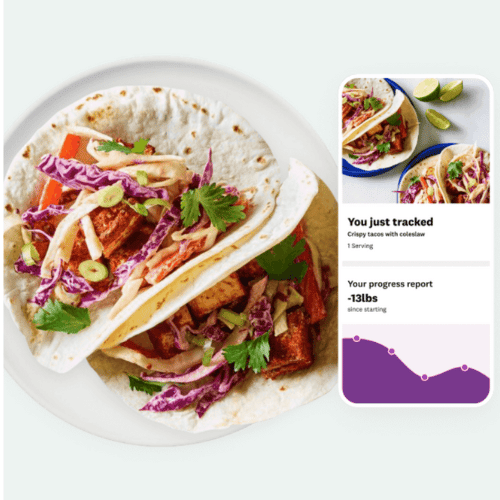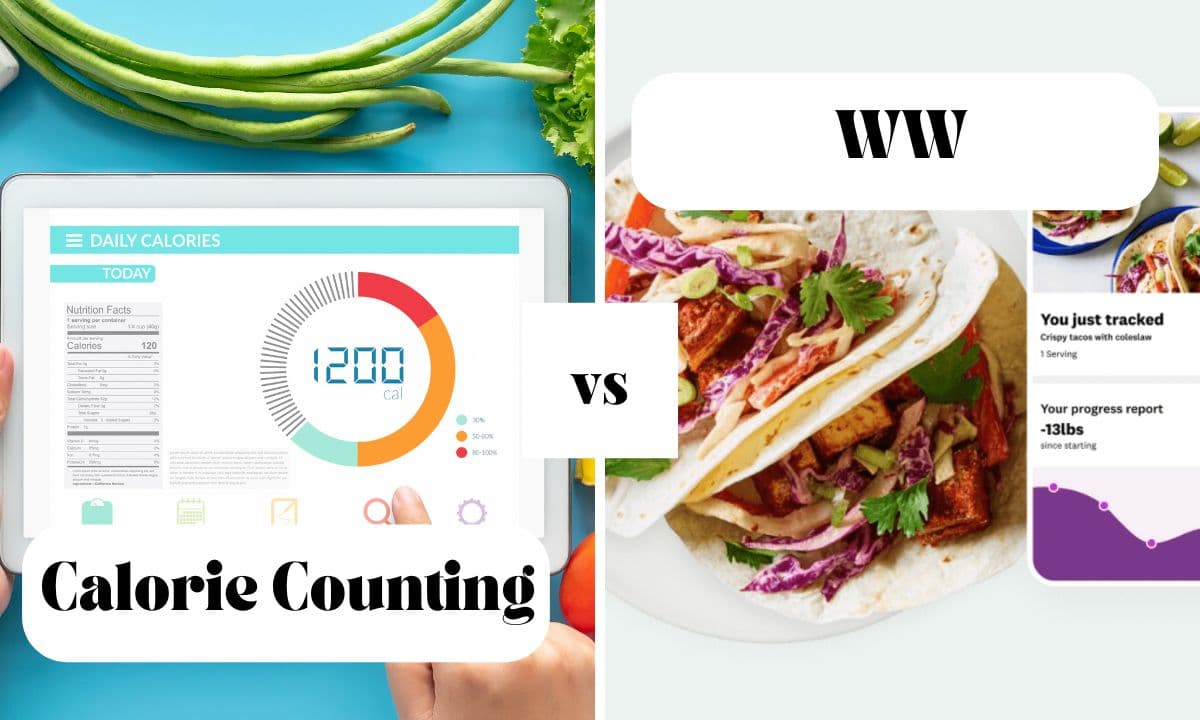WW vs Calorie Counting [The Dietitian Weighs In]
2023 WW Edition
Table of Contents
ToggleThere are a lot of different opinions on WW and calorie counting. Some people love WW, while others find calorie counting to be more effective. Here, the dietitian weighs in on the debate.
How WW Works

WW (formerly known as Weight Watchers) is a point-based weight loss system. WW assigns each member a number of points based on their personal information. Using an app, members keep track of what they eat with the goal of keeping within their daily point limit.
In WW every food item has a number of points depending on its nutritional value and caloric content. Keeping track of the points is easy using the WW app. You can enter the food manually or use the convenient barcode scanner to read the nutrition information.
Accounting for the nutritional value is one of the main differences between WW and calorie counting. Foods high in saturated fat and sugar are higher in points. On the other hand, lean protein and vegetables have low points.
Additionally, members can select from a large list of zero-point foods. These choices are designed to encourage members to add nutrients to their diet.
While not perfect, the system is designed to encourage WW members to make healthier choices to help them lose weight.
How do you know how many points you should be aiming for?
Upon signing up for the program, members get assigned a points budget. Members have daily points and weekly points. They can earn extra points by performing activities that enhance weight loss, such as physical activity.
It takes a small learning curve, but the WW app makes tracking points very easy. Also, there are classes to teach members how to use the app and how the program works.
Last, for an extra fee, members can attend in-person or virtual sessions with a WW coach.
How Does Counting Calories Work?

Just like the name implies, counting calories is all about keeping track of the calories you eat. If you’re trying to lose weight, the idea is to make sure you eat fewer calories than your body needs.
To make it easier to count calories, there are several apps that you can use. Popular calorie-counting apps include MyFitnessPal, Chronometer, and Lose It! The app will calculate how many calories you need considering your gender, age, and physical activity.
Similar to the WW app, you manually enter the food item or use the barcode scanner. Calorie-counting apps are very simple to use.
When using calorie counting for weight loss, it does not matter what food you eat or the timing of the meals. However, you will find that lean protein and vegetables have fewer calories than foods that are high in fat and sugar.
Do WW and Calorie Counting Help you Lose Weight?
Yes, both are powerful tools for weight loss. They both help you curb the total calories you eat.
Part of the success of both methods is the awareness they create. When you track everything you eat, it is much easier to eat only what you need.
Both programs allow you to eat anything you want, but you will quickly realize that foods high in fat and sugar are also high in calories and points. So, people make better choices to stay within their point or calorie allowance.
WW vs Calorie Counting: Diet Quality
To render a verdict, there is something we need to explore: not all calories are created equal.
Not too long ago, we believed that weight loss was merely a mathematical equation:
Total calories in versus calories out.
But new science has taught us that it’s not quite that simple.
Diet Quality
The quality of your diet can influence how efficiently your body burns energy. For example, a low-carbohydrate diet burns more calories more per day than a low-fat diet. This happens because the body needs more energy to digest certain foods.
The types of foods that you eat will determine the calories you have available after digesting and metabolizing them. This is called the thermic effect of food.
The difference can be significant.
Fiber

Then, there is the fiber issue. Your body cannot metabolize fiber. It comes in and goes out of your body, helping you to stay satisfied for longer in the process.
So eating fiber has a positive effect on weight loss and health.
Empty Calories
Foods high in sugar, such as candy, provide little or no nutrition. While they might not be high in calories, high-sugar foods make you crave more sugar in a matter of a few hours.
Additionally, many high-sugar foods provide calories without signaling your body the feeling of satiety (fullness).
For example, you can drink a 220-calorie soda and then be ready for a full meal. That’s a sharp contrast with eating a grilled chicken salad for the same 220 calories.

If you’re curious about the concept, read this wonderful explanation about why calories are not equal. You can also find out whether cutting out soda will make you lose weight.
Okay, let’s go back to our comparison.
WW vs Calorie Counting in Diet Quality
WW has done an amazing job of taking into consideration the quality of their diet when calculating points. A glazed donut is 11 points, which can be almost half of the daily points for some people. That doesn’t mean if you are following WW you can never eat a donut; the weekly points are available for that.
Beyond that, WW has a long list of zero points foods, which encourages eating a greater variety of food and more vegetables and fruits. As a result, members’ diet habits change for the better.
Calorie counting simply counts calories. But because you still have a budget of calories, people who count calories also tend to choose healthier foods. More importantly, calorie counting can make you aware of the number of calories in unhealthy foods and snacks.
WW vs Calorie Counting: The Other Components of Weight Loss
In addition to the number and type of calories you consume, there are other factors that can impact weight loss, such as physical activity, sleep, stress, and hydration.
WW rewards members with points for physical activity and allows for tracking water and sleeping in the app.
For calorie counting, if you use an app, you might also get additional calories when you workout out. This feature is often available in the paid version of the app.
You might be thinking that it doesn’t make sense to reward physical activity with food—and you’d be correct. But we need to remember that a body in motion stays in motion.
When you exercise, you’re more likely to move more through the day. Additionally, exercise can help you build more muscle, which leads to burning extra calories throughout the day.
So, depending on the method you use to track calories, both can encourage you to move more, which is beneficial both for your weight and your general health.
Support System
WW Support System
WW has a built-in support system that includes the following:
- Online communities
- Meetings
- Coaches
- Emails
- Challenges
- WW cookbooks
- Meal plans
- Recipes

All of these resources can help you stick to your goals.
The ability to attend meetings in person costs extra, but it’s well worth it. You have the choice to attend as many meetings as you want virtually or in person.
Meetings allow space for members to share experiences, and each week coaches share a new technique to aid with mindset. Meetings are very consistent across different coaches. Every coach also has an online community where the members can continue the conversation.
Calorie Counting Support System
Calorie-count apps have a support system too! Depending on which method of tracking you choose, you will have different support systems.
Apps such as MyFitnessPal have online communities, challenges, and emails with recipes and tools to help with your weight loss journey.
Communities and challenges can be very helpful in these apps. Also, you have the ability to share your information with friends and family for additional support.
The Cost
WW has different programs, with prices starting as low as $10 a month for six months for the basic plan (without meetings). If you choose to attend meetings, then the cost starts at $25.
Calorie-counting apps have free plans that allow you to track calories. Premium plans features can include customizable micronutrient tracking, guided fitness and meal plans, and insight analysis. The cost depends on the app you use. To give you an idea of the cost, MyFitnessPal premium plans start at $20 per month or $79.99 for the annual plan.
WW vs Calorie Counting: The Verdict?
Both will help you lose weight as long as you follow them accurately. However, WW can also help you build healthy eating habits that can make weight loss easier.
As a Registered Dietitian, I also value WW’s extensive support system that can help reach weight loss goals.
However, there is a lot of value to calorie counting apps too. Many dietitians use calorie counting along with nutrition counseling.
In the end, you have to try it and choose what works best for you.

Dr. Su-Nui Escobar, a Registered Dietitian/Nutritionist in Miami, FL, is dedicated to empowering women in perimenopause and menopause to live healthier, more satisfying lives.
With a doctorate in clinical nutrition from the University of North Florida, she has expertise in menopause and weight loss, including the unique challenges faced by those on weight loss medications.
Su-Nui’s passion for her field is evident in her previous role as the Academy of Nutrition and Dietetics spokesperson.


